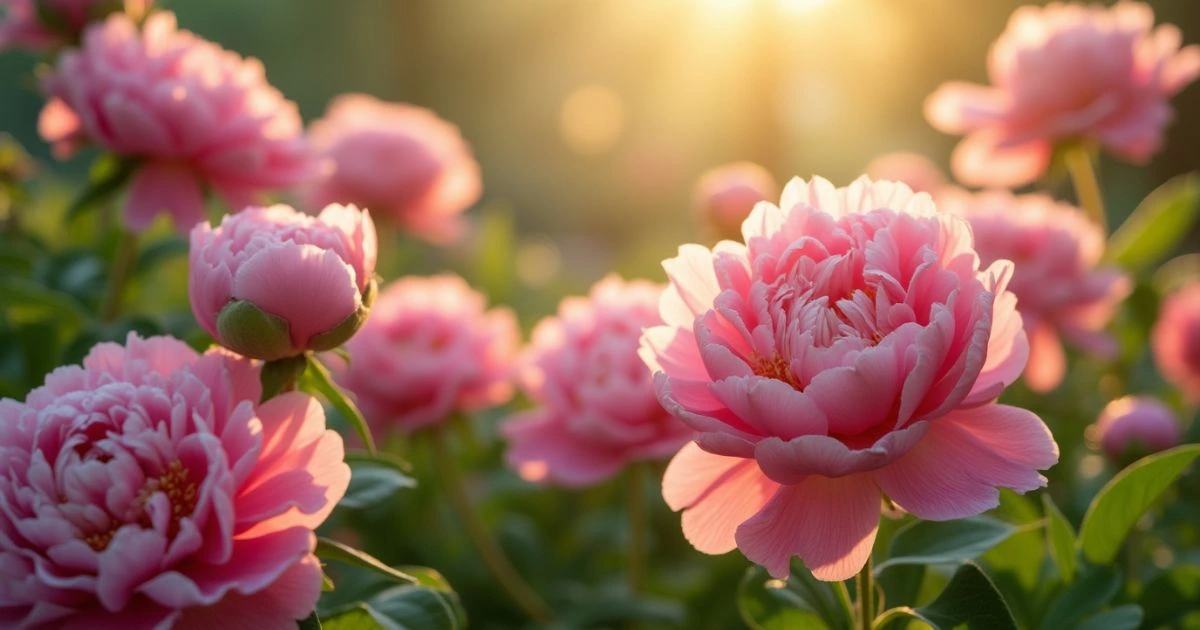When you think of elegance in a garden, what comes to mind? For many, it’s the striking beauty of pink peonies. These lush, vibrant flowers captivate with their layers of delicate petals and soft, romantic hues. But growing pink peony flowers can seem daunting for beginners, especially with their reputation for being a bit particular. So, how do you turn your garden into a haven for these stunning blooms?
Whether you’re just starting out or looking to refine your gardening skills, this guide breaks down the essentials in a simple, beginner-friendly way. From choosing the perfect spot in your yard to nurturing your peony pink plants through their seasonal cycles, we’ve got you covered. By the end of this guide, you’ll feel confident and ready to bring the charm of pink peonies to life in your own outdoor space. Ready to dig in and discover the secrets behind growing these timeless flowers? Let’s get started!
In This Article
| Common Name | Pink Peony |
| Botanical Name | Paeonia lactiflora |
| Family | Paeoniaceae |
| Plant Type | Herbaceous perennial |
| Mature Size | 2–4 feet tall, 2–3 feet wide |
| Bloom Time | Late spring to early summer |
| Toxicity | Non-toxic to humans, toxic to pets |
| Sun Exposure | Full sun (6–8 hours daily) |
| Soil Type | Well-drained, loamy soil |
| Soil pH | Neutral to slightly acidic (6.5–7) |
| Flower Color | Pink (various shades) |
| Hardiness Zones | 3–8 (USDA) |
| Native Area | Asia, Europe, and North America |
Understanding Pink Peonies
If you’re dreaming of a garden filled with soft, blush-colored blooms, pink peonies are the perfect choice. These iconic flowers have been adored for centuries, not just for their beauty but also for their symbolic meanings of romance, prosperity, and good fortune. But before you dive into planting, let’s explore what makes these flowers so special and why they deserve a spot in your garden.
What Makes Pink Peonies Unique?
Think about it—how many flowers can combine elegance, fragrance, and durability all in one? That’s exactly what pink peony flowers bring to the table. Here’s why they stand out:
- Timeless Beauty: Their large, layered petals create a stunning visual appeal in any garden or bouquet.
- Low Maintenance: Despite their luxurious look, they’re surprisingly easy to care for once established.
- Longevity: With proper care, peony plants can bloom for decades, making them a worthwhile investment for your garden.
Popular Types of Pink Peonies to Consider

Not all pink peonies are the same. There’s a world of variety to choose from, each offering its own unique charm:
- ‘Sarah Bernhardt’ – Known for its soft pink hue and ruffled petals, this classic variety is a favorite among gardeners.
- ‘Pink Hawaiian Coral’ – A vibrant coral-pink bloom that brightens up any garden.
- ‘Bowl of Beauty’ – Aptly named, this variety features striking contrast with creamy yellow centers and soft pink outer petals.
Consider mixing and matching these varieties to create a dynamic and visually stunning garden display.
Are Pink Peonies Right for Your Garden?
Before planting, ask yourself: Does your garden meet the needs of pink peonies? Here’s what they require to thrive:
- Climate Compatibility: Pink peonies grow best in USDA Zones 3-8, where winters are cold enough to promote blooming.
- Sunlight: They need at least 6 hours of sunlight daily to produce vibrant flowers.
- Soil Conditions: Well-draining, fertile soil with a slightly acidic to neutral pH (6.0-7.0) is ideal.
If you can tick these boxes, your garden is ready to welcome the unmatched elegance of pink peonies!
Why Choose Pink Peonies for Your Garden?

There’s something magical about the way pink peonies flowers transform a space. They’re not just plants; they’re a statement. Whether you’re looking to create a romantic border, enhance your landscaping, or enjoy fragrant blooms for your home, peonies bring unmatched value. Plus, who wouldn’t want flowers that symbolize love and prosperity blooming right in their backyard?
With the right preparation and care, pink peonies can become the star of your garden, offering beauty and joy season after season. Let’s keep exploring to ensure you have all the tools and knowledge to grow them successfully!
Preparing to Plant Pink Peonies
Planting pink peonies doesn’t have to be complicated, but getting the preparation right is crucial for success. Think of it as setting the stage for a long-lasting performance—your peonies need the right conditions to thrive and bloom beautifully. Let’s break it down step by step so you can give your plants the best possible start.
Choosing the Perfect Location
Where you plant your pink peonies flowers matters more than you might think. They love a spot where they can soak up plenty of sunshine while staying safe from harsh winds. Here’s what to look for:
- Sunlight: Choose an area that gets at least 6–8 hours of direct sunlight daily. Partial shade in the hottest afternoons can help prevent wilting, especially in warmer zones.
- Air Circulation: Avoid planting in low-lying areas where air stagnates. Good airflow lowers the risk of fungal diseases.
- Space to Grow: Allow at least 3 feet of spacing between peony plants. This ensures they won’t compete for nutrients and makes them easier to maintain.
Preparing the Soil for Success
Healthy soil is the foundation for thriving pink peonies. Before you plant, take a little time to improve the soil:
- Test Your Soil: Use a soil pH tester to ensure the pH is between 6.0 and 7.0. Pink peonies prefer slightly acidic to neutral soil.
- Enrich the Soil: Mix in compost or well-rotted manure to boost organic matter and improve drainage. Peonies don’t like sitting in soggy soil!
- Loosen the Ground: Till the soil about 12–18 inches deep so the roots can spread easily.
Selecting Quality Peony Roots
Not all peony roots are created equal, and starting with high-quality roots gives you a head start. Here’s what to look for:
- Healthy Roots: Choose roots with 3–5 “eyes” (the small buds where stems will grow). Avoid those that seem dry or moldy.
- Trusted Sources: Purchase from reputable nurseries or online stores. Look for recommendations from gardening experts or DoFollow links to reliable retailers.
Timing Is Everything
When is the best time to plant pink peonies? Timing plays a significant role in how well your peonies establish themselves:
- Fall Planting: Late September to early November is ideal for most climates. This allows the roots to settle in before winter.
- Avoid Spring Planting: While possible, spring planting often delays blooming and doesn’t allow roots enough time to establish.
Quick Checklist for Planting Preparation
Before planting your pink peony, make sure you have:
- The right location (sunny and spacious).
- Well-prepared, nutrient-rich soil.
- High-quality roots from a trusted source.
- The perfect timing for your climate zone.
By taking these steps, you’ll create the perfect foundation for your pink peonies to flourish. In the next section, we’ll dive into the planting process itself, giving you a simple, step-by-step guide to get those beautiful blooms growing!
Planting Pink Peonies Step-by-Step
So, you’ve chosen the perfect spot and prepared your soil—now it’s time for the exciting part: planting your pink peonies. Don’t worry if this is your first time; with the right steps, you’ll have those beautiful blooms in no time. Let’s walk through the process together.
Step 1: Timing It Right
Timing is everything when planting pink peony flowers. The best time to plant is in the fall, typically from late September to early November, depending on your region. This gives the roots a chance to settle in before winter dormancy, ensuring strong growth in the spring.
Step 2: Digging the Perfect Hole
Getting the planting depth right is essential for your pink peonies to thrive. Follow these tips:
- Depth: Dig a hole that’s about 12–18 inches deep and wide. This creates sufficient room for the roots to expand.
- Drainage: If your soil tends to hold water, add a layer of gravel or sand at the bottom of the hole to improve drainage.
- Enrich the Soil: Mix the removed soil with compost or well-rotted manure before placing it back into the hole.
Step 3: Positioning the Root
This step can make or break your pink peony’s growth, so take your time:
- Place the peony root in the hole with the “eyes” (small, reddish buds) facing upward.
- Keep the eyes no deeper than 2 inches below the soil. Planting too deep can stop or delay blooming.
Step 4: Filling and Watering
Once the root is positioned correctly, it’s time to fill the hole:
- Backfill the hole gently, firming the soil around the root as you go. Avoid compacting the soil too tightly.
- Water deeply to settle the soil and clear air pockets.
Step 5: Mulching for Protection
To protect your pink peonies through the winter months:
- Add a layer of organic mulch (like shredded bark or straw) around the base of the plant.
- Avoid covering the crown to prevent rot from developing.
Pro Tips for Planting Success
- Patience Is Key: Pink peonies may not bloom in their first year, as they focus on establishing strong roots. Trust the process, and you’ll be rewarded with beautiful blooms in subsequent seasons.
- Group Planting: If you’re planting multiple peonies, space them at least 3 feet apart to allow proper air circulation and growth.
By following these steps, you’re setting your pink peonies up for a successful start. With a little care and patience, your garden will soon be graced with their elegant beauty. In the next section, we’ll cover how to care for your peonies to ensure they bloom year after year!
Caring for Your Pink Peonies
Once your pink peonies are planted, the real magic happens with consistent care. These elegant blooms aren’t overly demanding, but they do thrive when given the right attention. Whether you’re dealing with their first season or maintaining mature plants, let’s explore how to keep your pink peony flowers healthy and vibrant year after year.
Watering Your Pink Peonies
Watering is essential, but it’s all about balance. Excessive water may cause root rot, while insufficient water can put stress on your plants. Here’s the way to get it just right:
- Establishing Plants: In their first growing season, water your peonies deeply once a week to help roots establish.
- Mature Plants: After the first year, water only during dry spells or heat waves. Peonies are relatively drought-tolerant once established.
- Pro Tip: Use a soaker hose to water at the base and avoid wetting the foliage, which reduces the risk of fungal diseases.
Fertilizing for Healthier Blooms
Peonies are light feeders, but a little boost can go a long way in enhancing their blooms:
- Spring Feeding: Apply a balanced, slow-release fertilizer (e.g., 10-10-10) around the base of the plant as new growth emerges.
- Post-Bloom Care: After flowering, use a low-nitrogen fertilizer to support root health without encouraging excessive leaf growth.
- Organic Options: Compost or aged manure can be used as a natural alternative to synthetic fertilizers.
Pruning and Deadheading
Pruning and deadheading play a critical role in keeping your pink peonies flowers healthy and tidy:
- Deadheading: Once blooms fade, snip off the spent flowers to direct energy back to the plant.
- Pruning in Fall: Cut back all foliage to ground level after the first frost. This helps stop pests and diseases from surviving through the winter.
- Disposal Tip: Dispose of clippings away from your garden to minimize disease risks.
Supporting Your Blooms
Large, heavy blooms are a hallmark of pink peonies, but they can sometimes cause stems to bend or break. Here’s how to give them extra support:
- Peony Rings: Install metal peony rings in early spring before the plant grows too tall.
- DIY Stakes: Use bamboo stakes and twine to create a supportive grid for your plant.
Common Pests and Diseases to Watch For
While pink peonies are generally hardy, they can encounter a few challenges:
- Botrytis Blight: A gray mold that can affect stems and buds, especially in damp conditions. Remove infected parts immediately.
- Aphids: Tiny sap-sucking pests that can damage new growth. Remove them with an insecticidal soap or a strong water spray.
- Ants on Buds: Ants are common on peony buds, feeding on their nectar. Don’t worry—they’re harmless and won’t harm your plants.
Seasonal Maintenance Checklist
Keep your pink peonies thriving with this seasonal care guide:
- Spring: Fertilize and support emerging stems.
- Summer: Deadhead spent blooms and water during dry spells.
- Fall: Prune back foliage and mulch for winter protection.
- Winter: Monitor for frost heaving in colder climates and re-mulch if necessary.
By giving your pink peonies consistent care, you’ll be rewarded with lush, healthy plants and abundant blooms. Up next, we’ll discuss how to handle common challenges and make the most of your peonies’ blooming season!
Maximizing the Beauty of Your Pink Peonies
Your pink peonies are more than just garden plants—they’re showstoppers that can elevate your outdoor space. To make the most of their bloom cycle and ensure they remain a focal point in your garden, there are a few tips and tricks to keep in mind. Let’s explore how to get the best out of your pink peony flowers season after season.
Prolonging the Bloom Cycle
Did you know you can extend the enjoyment of your pink peonies by staggering their bloom times? Here’s how:
- Select Varieties: Plant a mix of early, mid, and late-season pink peony varieties to enjoy blooms for up to six weeks.
- Cool Storage Trick: Cut peony buds when they’re soft but still closed, then store them in the fridge for up to two weeks. When you’re ready to display them, simply bring them out and place them in water.
- Regular Deadheading: Removing spent flowers encourages your plant to focus its energy on producing lush foliage, keeping the plant looking vibrant.
Creative Landscaping with Pink Peonies
Pink peonies flowers can add elegance to your garden, but where and how you plant them matters. Consider these ideas for a visually stunning landscape:
- Border Plants: Use pink peonies to line walkways or garden borders for a dramatic effect.
- Companion Planting: Pair peonies with plants like lavender, salvia, or delphiniums. These companions not only complement peonies’ colors but also help deter pests.
- Focal Points: Plant peonies in clusters to create a striking focal point in your yard or near an outdoor seating area.
Cutting and Arranging Pink Peonies
Freshly cut pink peonies flowers make stunning arrangements that can brighten any space. To keep your blooms looking their best indoors, follow these steps:
- Best Time to Cut: Harvest peony stems in the early morning when buds are soft but not fully open.
- Prepare the Stems: Remove leaves that would sit below the waterline to prevent bacteria growth.
- Longevity Tips: Use a clean vase with fresh water and add a floral preservative or a teaspoon of sugar to keep blooms fresh longer.
Troubleshooting Common Blooming Problems
Sometimes, despite your best efforts, your pink peonies may not bloom as expected. Here’s how to troubleshoot common issues:
- Planted Too Deeply: If the eyes of your peony root are buried more than 2 inches, this can delay blooming. Consider replanting in fall at the correct depth.
- Lack of Sunlight: Peonies need at least 6–8 hours of sunlight daily. If they’re in too much shade, consider transplanting them to a sunnier spot.
- Immature Plants: Remember, peonies may take 2–3 years to bloom after planting. Be patient—they’re worth the wait!
Showcasing Your Peonies
Why not let the world admire your hard work? Here are a few ways to share the beauty of your pink peonies:
- Photography Tips: Capture their beauty in the golden hours of morning or evening when the light is soft.
- Social Media Inspiration: Post your peonies on platforms like Instagram or Pinterest with tips about growing them, and connect with fellow gardening enthusiasts.
- Gifts: Create bouquets from your garden to share with friends and family—it’s a personal and heartfelt gesture.
Your Path to Peony Perfection
With a little creativity and care, your pink peonies can be the star of your garden and beyond. From extending their bloom time to designing elegant arrangements, these flowers are sure to make a lasting impression. In the next section, we’ll answer some of the most frequently asked questions about growing pink peonies, so you can tackle any remaining doubts like a pro!
FAQs About Growing Pink Peonies
Even with all the tips and tricks you’ve learned, you might still have a few questions about growing pink peonies. Don’t worry—you’re not alone! Below, we’ve answered some of the most common questions to help you become a confident peony grower.
Why Won’t My Pink Peonies Bloom?
Peony bloom issues are a frequent concern among gardeners. Here’s what might be the source of the problem:
- Planting Depth: If the “eyes” (growth buds) of your pink peony flowers are buried more than 2 inches below the soil surface, they may struggle to bloom.
- Age of the Plant: Young peonies often need 2–3 years to establish themselves before flowering.
- Sunlight: Peonies thrive with 6–8 hours of direct sunlight daily. Inadequate lighting may limit their ability to bloom fully.
- Improper Pruning: Cutting back foliage too early in the fall can deprive the roots of nutrients needed for flower production.
Can I Grow Pink Peonies in Pots?
Yes, you can grow pink peonies in containers, but it requires a bit more attention:
- Choose a large, sturdy pot at least 18 inches in diameter to accommodate the peony’s root system.
- Use well-draining soil, such as a mix of garden soil and compost, to prevent waterlogging.
- Provide consistent watering, as potted plants tend to dry out more quickly than those planted in the ground.
Remember, peonies in pots may not grow as large as garden-planted ones, but they can still produce stunning blooms!
How Do I Protect My Pink Peonies in Winter?
Peonies are hardy plants, but they can benefit from some winter protection:
- Mulch: Apply a thin layer of mulch, like straw or shredded leaves, around the base of the plant to insulate the roots.
- Avoid Over-Mulching: Be careful not to smother the crown with mulch, as this can lead to rot.
- Check for Frost Heaving: In very cold climates, freeze-thaw cycles can push roots out of the soil. If this happens, gently press them back down and add more mulch for protection.
Do Pink Peonies Attract Pests?
Peonies are relatively pest-resistant, but a few issues can arise:
- Ants: These insects are often seen crawling on peony buds, but they’re harmless. Ants are drawn to the sweet nectar on the buds and don’t damage the flowers.
- Botrytis Blight: This fungal disease can cause buds to rot and stems to wilt. Prevent it by ensuring proper air circulation and removing infected parts promptly.
- Aphids: Small, sap-sucking insects that can appear on new growth. Use insecticidal soap or a strong spray of water to eliminate them.
Can I Divide My Pink Peonies?
Yes, dividing your pink peonies can rejuvenate older plants and create new ones for your garden:
- The ideal time to divide peonies is in the fall, once the foliage has withered.
- Carefully dig up the plant and use a sharp, clean knife to separate the roots into sections, ensuring each has 3–5 eyes.
- Replant the divisions immediately, following proper planting guidelines.
How Long Do Pink Peonies Live?
One of the most amazing things about pink peonies flowers is their longevity. With proper care, they can live and bloom beautifully for 50 years or more! They’re a true investment in your garden’s future.
Your Peony Questions, Answered!
If you’ve been hesitant to start growing pink peonies or have run into challenges along the way, these answers should give you the confidence to move forward. Remember, peonies are resilient and rewarding plants that thrive with a bit of care and patience. Ready to put these tips into action? Let’s get growing!
Conclusion: Wrapping Up Your Pink Peony Journey

Growing pink peonies is a truly rewarding experience, whether you’re a seasoned gardener or just starting your journey. These stunning blooms bring timeless beauty to any garden, filling your space with vibrant colors and elegance year after year. With the tips and insights you’ve gained—from selecting the perfect planting spot to troubleshooting common challenges—you’re now equipped to nurture these breathtaking flowers with confidence.
Imagine the joy of seeing your pink peony flowers thrive, their lush petals glowing in the sunlight. The effort you put into caring for them will pay off not only in visual splendor but also in the pride of knowing you’ve created something so beautiful.
So, what’s next for you and your garden? Will you experiment with new varieties of pink peonies or perhaps incorporate them into fresh floral arrangements? The possibilities are endless, and your garden is your canvas.
As you take these next steps, remember: patience and care are the keys to success. Peonies are resilient and forgiving plants, ready to reward you with blooms that last for decades.
Don’t let your peony passion stop here! Stay curious, keep learning, and share your progress with fellow gardening enthusiasts. Whether it’s through social media, community groups, or just chatting with friends, your experience can inspire others to grow their own pink peony paradise.
Let’s keep the conversation going. If you have any lingering questions, don’t hesitate to check out the FAQ section or reach out to your gardening network. Together, we can ensure that every gardener’s dream of growing the perfect pink peonies becomes a reality.
Here’s to a garden full of color, joy, and thriving pink peony flowers—one bloom at a time!

